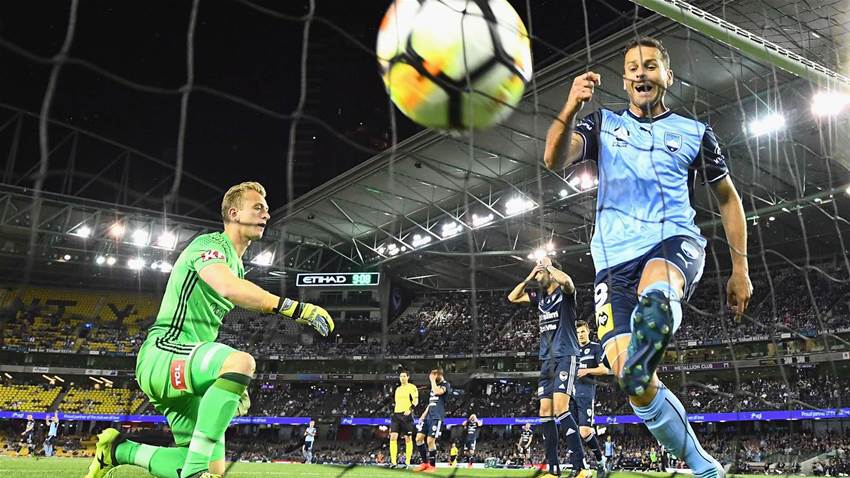A repeat of last season’s grand final was headlined by a solid defensive performance from Sydney FC, who went away with three points courtesy of a Thomas Deng own goal in the second half. The result meant that after 43 Big Blue derbies, both sides had won 13 each, setting up an interesting season in which both sides are expected to be title contenders.
Sydney’s defensive scheme
Sydney FC under Graham Arnold are arguably have the best defensive set-up in the history of the A-League. Not only do the physical movements and tactics stand up to the most talented players in the country, but so does the mental toughness of the players. Watching them play, it can be seen that the players completely believe in their approach, to the point where it seems that they don’t believe they will concede a goal – and for this, full credit must be given to Arnold.

Sydney’s compact 1-4-2-3-1 out of possession
As mentioned previously, Sydney’s defensive approach is built upon having numerical superiority (simply, having more players in a given area than the opposition) in central, and the most threatening, areas of the pitch. In this sense, it is a prerequisite that the defensive unit must be in a compact block, reducing the distances between members of the team.
The compactness of a defensive block restricts the space available for the opposition to play in, while at the same time offering cover for teammates who may be beaten in one v one situations. As shown above, Sydney enjoyed superiority in central areas for virtually the entirety of the match. This structure also facilitates in the initiation of counter attacks, as the opposition will move men forward in an effort to equalise or overload a certain area of the defensive block, creating space in the vacated regions of the pitch.

Sydney’s transition to a 1-4-4-1-1 and subsequent avoidance of opposition overload
In an effort to alleviate the danger posed by Victory’s attacking fullbacks, the second half saw a transition to a 4-4-1-1 when the ball moved into wide areas. The defensive block maintained its core stability with three longitudinal lines, allowing for an adequate coverage of vertical space. When the ball moved from the centre to the outside, the two holding midfielders step up to form a four man second line, allowing for the closest player to press the fullback in possession of the ball (Jason Geria above).
This movement not only equalised the superiority Melbourne previously utilised in these areas, but also created a free centre-back, allowing for more effective tracking of runs beyond the offside line. Overall, Graham Arnold’s team were able to respond successfully to the strengths of the opposition while at the same time maximising their own, culminating in the concession of no shots on target over the entirety of the ninety minutes. It truly was a terrific defensive performance from the reigning champions, largely restricting their talented opposition to chances from unlikely locations.
Summary
A tight affair was in the end settled only by an own goal, but it was the defensive performance of Sydney FC which was perhaps the biggest take away. However, the Sky Blues’ forward movement was generally quite effective, and perhaps should have lead to at least one more goal when Luke Wilkshire’s shot was saved by Thomas. Melbourne’s searching for numerical superiority was successful until an in-phase transition from Sydney in the wider areas, topping off a well-earned clean sheet for the away side and kicking off their title defence with a win.
Nathan Muir is an Australian tactical analyst and coach. You can contact him on Twitter @NathanKMuir.
Related Articles
.jpeg&h=172&w=306&c=1&s=1)
Langerak to bolster Victory's ALM title bid in January

Socceroo-in-waiting seals Championship deal













